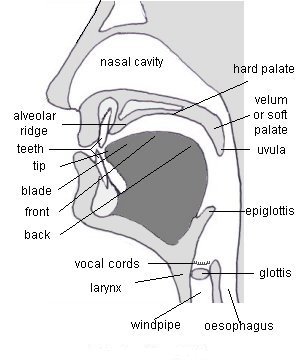The Sounds of English. Pronunciation of English Sounds
This interactive chart contains 44 sounds used in British English speech. If you click on the sound, you will hear the pronunciation of this sound. To read the information how to pronounce the sound, click on the icon . All the sample words are clickable too, so you can click on any word and listen to its pronunciation. The letters in bold type show where the sound is heard in this word.
English Vowel Sounds
English Diphthongs
English Consonant Sounds
Reference. About the Sounds of English
The Organs of Speech and Their Work
 In order to pronounce the sounds of English correctly, you should have a general notion of organs of speech (or articulators) and know what position they take in producing different sounds. The most important organs of speech include the lips, teeth, tongue, alveolar ridge, hard palate, soft palate (or velum), uvula and glottis.
In order to pronounce the sounds of English correctly, you should have a general notion of organs of speech (or articulators) and know what position they take in producing different sounds. The most important organs of speech include the lips, teeth, tongue, alveolar ridge, hard palate, soft palate (or velum), uvula and glottis.
When we speak, our lungs push air up past the vocal cords and through the rest of the vocal tract (the space in the throat, mouth and nose where sound is produced).
The vocal cords are in the larynx. In the production of voiceless consonants the vocal cords are relaxed and apart. When the vocal cords are stretched tight and close together, they vibrate rapidly, and their vibration produces voice we hear in articulating vowels and voiced consonants. Try to touch the larynx and pronounce any vowel or voiced consonant, and you can feel the vocal cords vibration. If you pronounce a voiceless consonant like [k] or [s], you don’t feel any vibration.
The organs of speech ( or articulators) used to produce sounds:
The tongue is a very important organ of speech. It is involved in producing almost all the sounds of English and usually divided into four parts: the tongue tip, the blade, the front and the back of the tongue.
The lips are used in the production of several consonant sounds [p], [b], [m, [w], [f] and [v]. The way we move our lips also influences on the production of some vowel sounds.
The teeth are used when we pronounce [f], [v] and [θ], [ð].
The alveolar ridge is the slightly rough area just behind the top teeth. It is also called the tooth ridge or the gum ridge. This organ of speech is used in the production of the sounds [t], [d], [s], [z], [l] and [n]. The tongue touches or almost touches the alveolar ridge when we say these sounds.
The hard palate, also called the roof of the mouth, is the hard part at the top of the mouth. It begins just behind the alveolar ridge.
The soft palate (or velum) is the softer part of the roof of the mouth, farther back than the hard palate. If you touch the roof of your mouth with your tongue and then keep moving your tongue farther back, you’ll find that softer area. The last part of the soft palate is called uvula.
The space between the vocal cords is called the glottis.
Vowel Sounds in English. Monophthongs and Diphthongs
A monophthong is a pure vowel sound like [ɔː]. It consists of only one vowel sound articulated without change in quality throughout its duration (it comes from Greek monophthongos: monos ‘single’ + phthongos ‘sound’).
A diphthong is the combination of two different vowels within the same syllable (for example, [aɪ]). It comes from Greek diphthongos: di- ‘twice’ + phthongos ‘voice, sound’. It is also called a gliding vowel because it starts at or near the articulatory position for one vowel and moves to or toward the position of another. The first vowel has more emphasis because its duration is longer. The second vowel is usually shorter and not so loud as the first one.
Consonant Sounds in English
A consonant is a speech sound made by stopping all or some of the air going out of your mouth. English consonant sounds are pronounced vigorously. There are approximately 24 consonants in English, and they are classified according to manner of production, place of production, and voicing. All this information is given in descriptions of the sounds. To read it, click on the icon .
